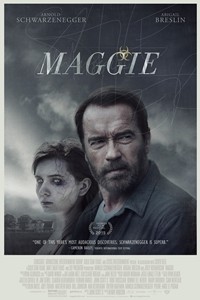 Maggie
Maggie
Starring Abigail Breslin, Arnold Schwarzenegger and Joely Richardson
Directed by Henry Hobson
From Lionsgate
Rated PG-13
95 minutes
By Michael Clawson of Terminal Volume
The zombie is an ironic metaphor for, of all things, the zombie genre: it shambles forward, meat decaying off its bones, teeth falling from its mouth, unable to die, its only mission to consume. You can shoot it and delay its momentum, but it just keeps coming back for more.
After every iteration of zombie cross-pollination — zombie comedy (Shaun of the Dead), Zombie rom-com (Warm Bodies), zombie sci-fi (The Last Days on Mars), zombie suburban drama (Fido) — and an increasingly manipulative zombie soap opera on television (The Walking Dead), we must certainly be approaching a zombie zenith. After all, how many zombie movies, shows, comics and video games do we really need?
“One more, please,” begs Henry Hobson’s directorial debut Maggie, a largely unique zombie movie with something to say in an overplayed and babbling genre.
The film plays out in whispers, sighs and reserved mumbles. It’s quiet and contemplative, the kind of movie that doesn’t feel rushed when it looks out a window to wonder. It’s been months, or maybe years, since a zombie uprising has been quelled. Survivors are picking up the pieces and rebuilding, but infected still pop up now and again. They aren’t called zombies — no, they are carriers of a fatal disease called the necroambulist plague — and are treated humanely, more like terminal cancer patients than a horror villain.
The bad ones, the run-of-the-mill walking dead, are killed outright, but the infected who are still conscious and articulate are granted small doses of humanity. They’re allowed to return home, be near their families, eat and drink regular food, and put their affairs in order before the virus’ two-week incubation period gives way to full-blown braaaaaaains cravings. Before patients “turn” they are encouraged to voluntarily enter a quarantine center where they will be housed and later euthanized, or a family member can end it all for them. “I would use that,” the family doctor says, pointing at a shotgun.
This is the world that we enter as we meet Wade, a father of three somewhere in the Midwest. The state of Wade’s world is explained in an overly helpful NPR story — if All Things Considered is still around, then things probably didn’t get that bad. Wade’s teen daughter, Maggie, has been bitten and he’s bringing her home to the family farm. No one is really trying to process Maggie’s fate; it all feels so raw, so they ignore it. They cook and make dinner, she uses a swingset in the yard, she goes to a party … life is mostly normal, except this bite and its putrefying aftermath that represents Maggie’s future.
I haven’t yet told you the stars of the movie, and that is intentional. Maggie is played by Abigail Breslin, the young child actress from Little Miss Sunshine and, as luck would have it, Zombieland, who is making waves now as an adult. Wade is played by Arnold Schwarzenegger in what might be the most unique role of his career. He holds a gun, but only shoots it offscreen. He’s involved in two fights, and is roundly defeated in one of them. And he doesn’t have a single one-liner. Where other movies are built around this abstract idea of AHNOLD, Maggie casts the former California governor as a regular guy doing mostly regular things. And you know what? It works. By no means is this prestige acting, but it’s a serious role that requires him to act and not stunt. I was continuously surprised by his performance and his pairing with Breslin, who also does a fine job with the minimalist material.
Maggie is original as a zombie movie and a Schwarzenegger flick, but it occasionally loses its way. There’s a bit with a roaming fox that goes on with little reward, and some of the visual payoffs look like hand-me-downs from The Walking Dead. In one of the film’s only zombie fights, Wade wanders through a deserted gas station, past a bloody mattress, through buzzing flies and into a dark hallway to use the bathroom. Of course there’s a zombie by the toilet that he has to fight off, but why didn’t he read the clues? More importantly, how did he even survive the original zombie plague with instincts like this?
These deficiencies are made up for with Hobson’s careful directing, which (mostly) avoids cheap jump scares and rapid edits for a deliberate, more cerebral story about a father and a daughter as they comprehend the limits of their love. The music is mellow and evocative, the colors are cold and desaturated, the editing is straightforward and direct, and the performances are flat but also realistic — Hobson takes into account what’s already been done in the zombie genre and goes out of his way to tell a different kind of story. And it’s pretty good.
So maybe the genre isn’t altogether dead.









